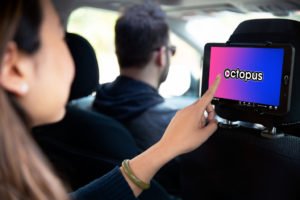Octopus Interactive operates a national network of interactive screens inside Uber and Lyft vehicles. Cherian Thomas, Octopus CEO, told Mel Stott his company’s business model and plans for growth.
You promote Octopus Interactive as the largest network of interactive screens inside Uber and Lyft vehicles. In how many vehicles do you have screens? What’s the process for adding drivers to your network?
The Octopus network now includes over 15,000 active screens in the top DMAs across the country. Pre-pandemic growth rates indicated that by the end of 2020, Octopus would have over 30,000 active screens — creating the largest moving DOOH network in the country.
Octopus partners with the best Uber and Lyft drivers in the country. We qualify drivers based on DMA, rides per month and performance ratings.
Once a driver is qualified, Octopus provides them with a free screen, LTE data, accessories and self-installation guide. To date, drivers have earned over $10 million in direct and estimated indirect revenue – added tips from riders — through Octopus.
Washington Post reported Uber and Lyft rides were down 80% in May. Uber has laid off 3,700 employees, and Lyft has laid off 1,000 people. How has the pandemic affected your business?
While Lyft and Uber ridership are both down dramatically from where they were this time last year, we have been seeing promising signs of demand recovery. Lyft rides in May were up 26% from April. That growth came from cities where Covid-19 restrictions have been eased. We expect that trend to continue when the June numbers are released.
We believe many passengers see ride hailing as a safer alternative to public transportation. During the pandemic-triggered slowdown, Octopus has been investing in expanding our direct sales and marketing teams.
We have also enhanced the platform to allow passengers to interact with our screens through their phones.
Both Uber and Lyft say they comply with strict pandemic safety protocols.
Please tell us about some of the interactive content on Octopus screens. How do you engage with rideshare passengers?
Octopus is a lean-in rider experience featuring a combination of interactive games such as Trivia, Photo Hunt and the Match Game (to win prizes), reactive surveys, driver information, weather and more.
The content is funded by ads and in-game branding. Our screens receive over 1.5 million interactions per day and will cross the two million daily interactions mark by early Q3.
Who are some of your major advertisers? Can you offer a detailed example of how they use Octopus screens’ interactivity?
Top-tier brands including Disney, Walmart, T-Mobile, CBS, H-E-B, Marriott, FanDuel have taken advantage of our interactive DOOH platform, among other clients.
As an example, H-E-B, the leading grocery brand in Texas, used Octopus Studios, our in-house creative agency, to develop a branded “Find the Ball” game to promote their KODI tumbler. This particular activation has achieved a 6.83% click-through rate, generating a significant number of opt-in leads.
Does Octopus Interactive generate other revenue, aside from ad sales? Do rideshare drivers pay to have the screens installed?
We are an ad-supported publisher. Our goal is to capture the attention of the rideshare passenger and monetize that attention through non-invasive video ads and branded games.
While our primary revenue comes from interactive ads, some of our clients pay for branded games and reactive surveys.
Drivers do not pay for tablets or their installation but, as mentioned earlier, must qualify to join Octopus. Naturally, riders play for free and have full control over volume, brightness and on/off features.
How do Octopus screens benefit rideshare drivers?
While ridesharing continues to grow (in non-pandemic times), driver earnings from the rideshare platforms have dropped 50% over the past five years.
Octopus helps drivers increase tips and overall earnings per hour. Driver earnings are uncapped; they are compensated based on drive hours and screen engagement. To date, drivers have earned over $3 million in direct payments from Octopus and report an average 31% increase in tips.
Can you target ads by location and, if so, through whose technology?
Yes, Octopus screens are on LTE connectivity and provide real-time location to our ad servers. We can serve ads programmatically through Vistar, or directly through our own proprietary ad server.
Our proprietary “Geo-Boost” technology allows for dynamic ad selection based on real-time location. Brands use these capabilities to increase frequency or change content based on the vehicle location.
For example, Ugg activated a campaign in Manhattan over the holiday season to increase brand exposure around store locations. In this campaign, they were also dynamically changing creative to fit their uptown and downtown locations.
FanDuel sports betting ads were geo-boosted to only play within the state lines of New Jersey, thus adhering to state gambling regulations.
How many people view Octopus screens each day, and what type of attribution metrics do you provide to advertisers?
Before March 2020, Octopus had been reaching over 4 million unique passengers per month in the backseats of Uber and Lyft vehicles across the country. The most active days were Thursday to Saturday.
Brands and agencies running campaigns with Octopus have access to our live client dashboard. They are able to track campaign performance daily. They can actually see real-time impression numbers and live rideshare cars playing their ads on a map. Additionally, they are able to track impression delivery by market, location, day and time at the top of the funnel and engagement rates, lead generation and conversion at the bottom of the funnel.
Brands that use reactive surveys and branded games can also track response volume and gain insights from passenger preferences.
Learn more about Octopus Interactive here
Learn what’s new at DPAA .
